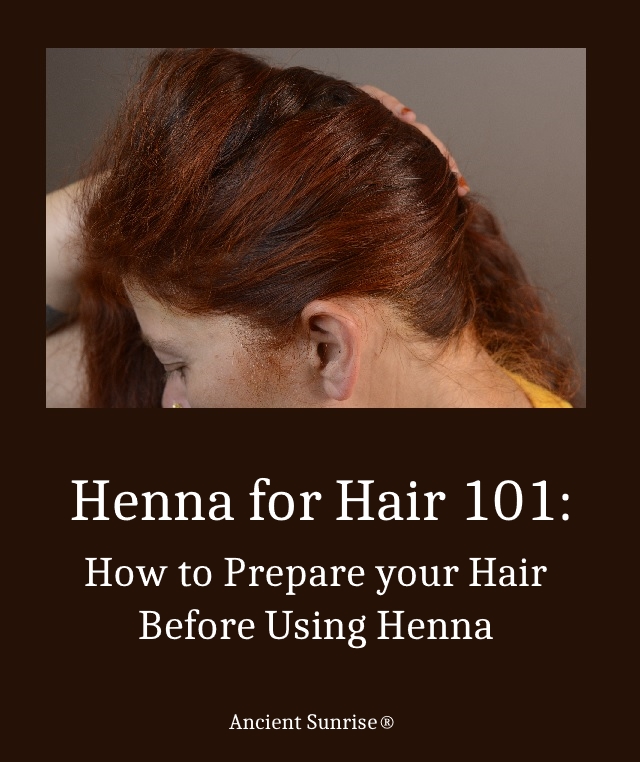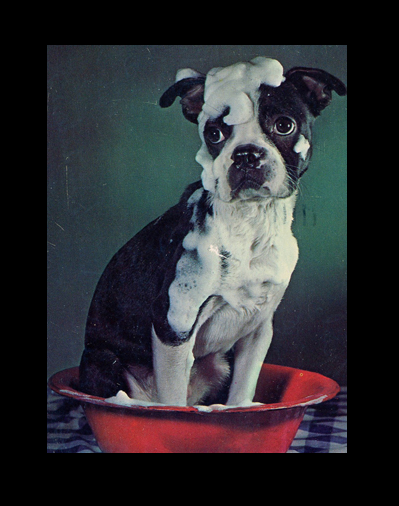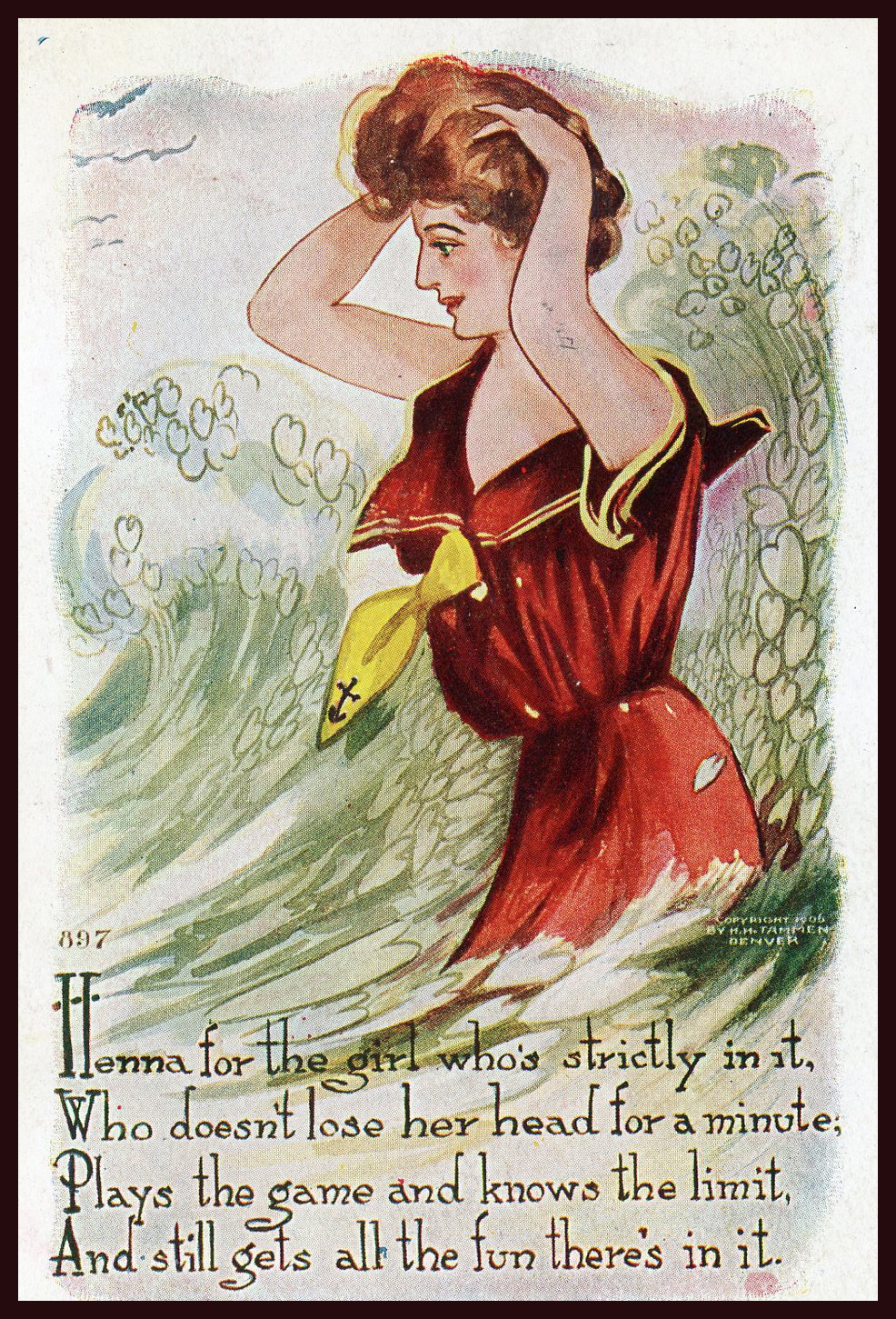
People frequently ask what they should or should not do to their hair before applying henna. Does hair need to be clean, or left unwashed? Can it have conditioner on it? Should it be wet or dry? As henna works differently from conventional hair dyes and treatments, these questions are valid. This article will explain the best ways to prepare your hair for your henna treatment to obtain the best results.
First of all, hair should definitely be clean. But “clean” means several things. For henna and plant dye mixtures, it means, 1) free of dirt; 2) free of oils, both natural and added; and 3) free of mineral build-up. Dirt, oil, and mineral build-up all create barriers that prevent the dye from binding properly to the hair strand, for the best coverage and permanence, it will be important to start with squeaky-clean hair. Second, it is important to avoid adding oils or conditioning products to the hair prior to using henna, as they can inhibit dye uptake. Finally, hair can be either damp or dry when applying henna, whatever makes the hair easier to separate into sections for application. Continue reading to learn more about how to prep your hair and why.

Remove Dirt
When left unwashed, hair collects dirt and pollutants from the environment, as well as dead skin and materials excreted through the sweat glands. Combined with the body’s natural oils and heat, the hair becomes a perfect playground for bacteria and microbes.
While henna has anti-microbial properties, it does not necessarily make for the best hair cleanser. Henna is best known for its coloring and strengthening properties, which come from the dye molecule, lawsone. Dirty hair does not allow for as much dye uptake as clean hair, therefore limiting the benefits. No one wants to go through the process of applying henna and leaving it on for several hours just to see that their hair was not colored sufficiently.
The simplest way to remove dirt is with a standard detergent shampoo. A clarifying shampoo would be even better. Shampoo bars, natural shampoos, and shampoo alternatives may not effectively clean the hair of dirt and oil, and may actually leave a residue which creates an additional barrier. Baking soda does not clear out sebum as effectively as shampoo, and may interact negatively with dye molecules.
Ancient Sunrise® shampoo bars and Ancient Sunrise® Zizyphus Spina Christi powder are great cleansers for any time other than right before henna. The shampoo bars are oil-based, and Zizyphus leaves a natural waxy coating on the hair. If you use either of these, it is recommended to wash your hair with a regular detergent or clarifying shampoo to remove any residue.
Remove Oil
While it is important to wash away the dirt and oil that naturally accumulates in the hair, it is equally important to avoid applying any additional oils. If you use oils or conditioners, these need to be washed out.
Indigo is particularly sensitive to barriers such as oil, and will not bind as successfully unless the hair is completely clean. Those who have particularly resistant hair may want to try washing their roots with a few drops of dish soap. Dish soap is a strong detergent that will strip out any oils and temporarily rough up the cuticle to allow for better dye penetration.

Remove Mineral Build-up
Minerals from tap water accumulate in the hair over time. They can cause the hair to feel drier and more brittle, prevent dye uptake, and affect the color. Hennaed hair will darken with mineral build-up. Cassia can react with minerals in the hair, turning the hair muddy-colored or greenish rather than golden.
Ancient Sunrise® Rainwash Mineral Treatment is great to use prior to henna treatments, and regularly to keep the hair bright and soft. Those who live in areas with hard water will notice the effect of minerals more quickly and will need to clean their hair of mineral build-up more often. All tap water contains some level of mineral content, so Rainwash is always a safe bet, no matter what type of water you have.
Rainwash comes in powder form. Mix it with distilled water until it thickens into a gel consistency. Apply throughout the hair, wrap the hair with plastic, and leave it in for 15-40 minutes. A deep cleanse will require forty minutes, while fifteen is enough if you are using the product regularly. During this time, the product is dissolving minerals out of the hair, and it is normal to notice a metallic or sulfur smell. Rinse well. Using a dab of shampoo will ensure that all of the gel and minerals are thoroughly rinsed out.
Avoid Conditioner and Oils
For best dye results, it is important to skip the conditioner before applying henna. As mentioned before, oils create a barrier and prevent the dye from binding properly to the hair. The glycerin and silicone compounds in conditioning products do the same.
Some people are concerned that their hair will be difficult to manage without conditioner. A vinegar rinse can help to keep the hair slippery enough to work with. Do this as the last step after using Rainwash and shampoo. Rinsing the hair with cool water can also help the hair become smoother.
Wet or Dry?
Finally, people commonly ask whether to apply henna to wet or dry hair. Either way is fine; whatever makes your hair easier to separate into sections. Hair should be at least towel-dry, or the paste is apt to get thin and runny once it is on. Also, be aware that hair is more fragile and prone to stretching while wet.

Best Practice
Putting all of this information together, here is the best way to prepare your hair before henna.
1. Mix and apply Ancient Sunrise® Rainwash according to the instructions.
2. After leaving the Rainwash mixture in your hair for the recommended amount of time, rinse your hair and use a detergent or clarifying shampoo.
3. For extra oily or dye-resistant hair, use a few drops of dish soap.
4. Remember not to use conditioner.
5. If skipping conditioner makes your hair unmanageable, rinse your hair with diluted vinegar and cool water to give it extra slip.
6. Dry your hair to the point where it is no longer dripping. Damp or fully dry hair is fine.
7. It is best to do all of this right before applying henna, rather than the day or evening before.
When Doing a Two-step Process for Black Hair, or Re-applying a Mix
The above information applies to using henna and indigo in two separate steps, or any time when another mix is used shortly after the first one, such as in the case of missed spots or a result that is too light.
It is especially important that the hair is clean and free of oils before applying indigo. If you are applying both steps of a two-step process on the same day, simply rinse and shampoo out the henna paste, towel- or blow-dry your hair, and apply the indigo. Indigo can be applied up to 48 hours after rinsing henna; if you plan to wait, it is important to wash your hair again right before you apply indigo.
As a general rule of thumb, any time you plan to apply a plant dye mixture to your hair, it is best to have it as clean as possible immediately prior to application.
If you have any additional questions, don’t hesitate to contact Ancient Sunrise® Customer Service via phone, email, or online chat at www.mehandi.com.
